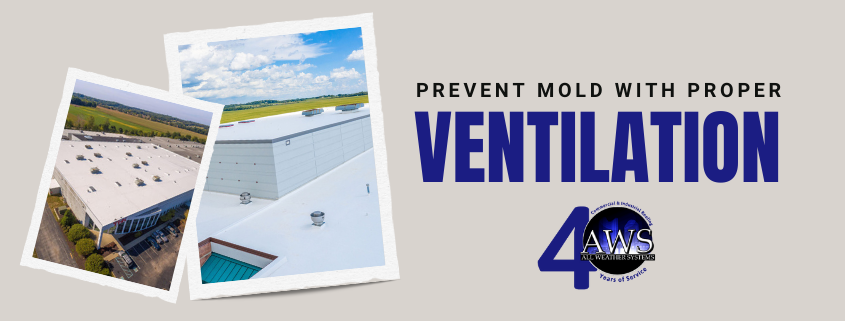After forty years of serving Ohio businesses, we know better than most that proper ventilation is a critical component of any flat or low-slope roofing system. While flat roofs offer advantages like extra space and easy accessibility, they can be more prone to moisture issues without adequate ventilation in place. This results in moisture accumulating beneath the roof membrane, leading to potential mold growth and structural damage over time. Keep reading to learn more about the importance of flat roof ventilation, and how All Weather Systems can help!
Moisture: Your Roof’s Nemesis
Moisture is the number one enemy of any roof. Whether from condensation, rainwater, or excess humidity levels inside the building, trapped moisture sitting on or below the roof surface can wreak havoc. It saturates insulation and wood decking, causing materials to rot and structural integrity to decline. It also provides the perfect breeding ground for mold and mildew growth on both the roof and within the building. Beyond damaging the physical roof assembly, excessive moisture poses health risks and can compromise indoor air quality for business occupants.
To combat these issues, proper ventilation is key. Simply put, ventilation works to remove moisture from the roof surface before it has the chance to cause damage. Commercial flat and low-slope roofs should include both passive and active ventilation components. Passive ventilation like the Duro-Last 2-way air vent utilize techniques like cross-ventilation and ventilation strips cut into the insulation to allow natural airflow. Meanwhile, active components use mechanical systems like thermostatically controlled exhaust fans to pull warm, moist air from eaves and ridgelines.
A Winning Team: Combining Flat Roof Ventilation Systems
Together, passive and active ventilation creates circulation to wick moisture away and release it into the open air. This helps maintain a healthy atmosphere within both the roof and interior spaces below. Proper design is also vital – components need to be installed correctly and adequately sized to match the square footage and airflow needs of each specific roof area. An experienced roofing contractor can help specify the right ventilation solution based on factors like building size and climate.
Beyond initial installation, routine maintenance plays a huge role in ensuring continuous ventilation performance. Debris and dirt can easily clog vents over time, inhibiting airflow. Our team at All Weather Systems can help you perform regular inspections and cleaning to clear ventilation points and confirm maximum circulation is maintained long-term. Early detection of any blockages prevents moisture from building to dangerous levels within the roof assembly!
At All Weather Systems, we have the know-how to specify and service Commercial flat roof ventilation needs with optimal performance and durability in mind. With over 40 years in the industry, our expert technicians can assess your existing ventilation and recommend upgrades or enhancements to keep your roof assembly functioning at peak efficiency. We’re committed to delivering long-lasting protection that safeguards your business operations and investment. Contact us today to discuss options for your building and experience the difference that proper roof ventilation can make.
